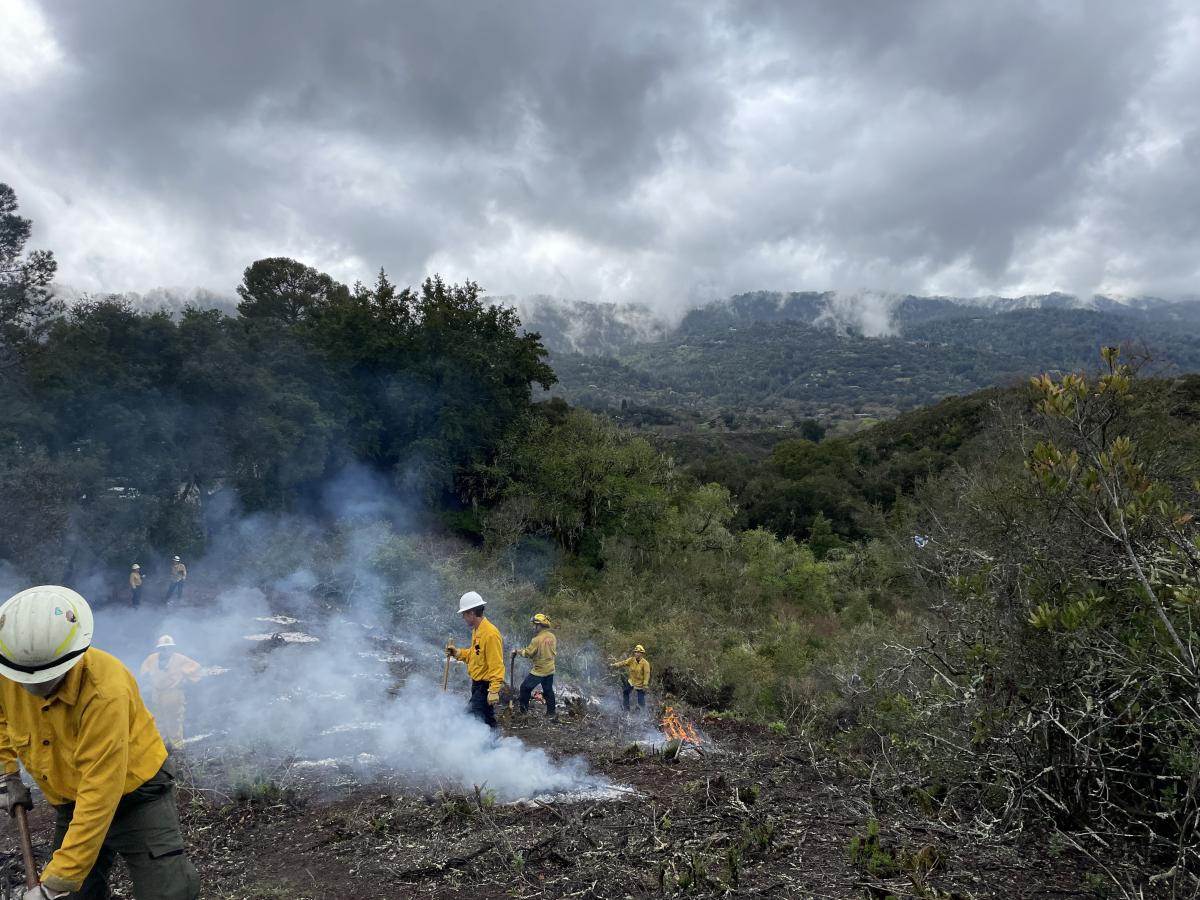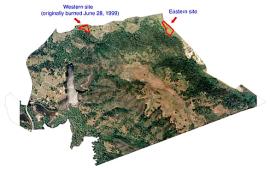Prescribed Burning
Why burn?
Fires are a natural part of many California ecosystems, including those at Jasper Ridge, such as grasslands, oak woodlands, and chaparral. Fire ecology shows us that these fire-adapted ecosystems benefit from these periodic disturbances which initiate nutrient cycling, reduce litter and vegetation, trigger germination and regrowth, create habitat heterogeneity, and reduce pests, among many other natural processes. Cultures across the world have understood these benefits and have used fire as a tool for conservation and cultivation. There are Indigenous peoples who have extensive Traditional Ecological Knowledge related to burning in different seasons and at different intervals to promote the growth of specific species, clear brush, and create habitat. Fire can also play a role in building community and in ceremonial practices.
In addition to the ecological and cultural values of fire on the landscape, prescribed burning is also used as a tool to reduce fuel in the landscape to minimize the risk of a large and high-intensity fire by creating a controlled, low-intensity fire set under favorable conditions and managed by trained fire personnel (see recent study by Stanford researchers here).
2024 Pile Burning for Vegetative Fuel Reduction

Burn crew mebers work under the supervision of the Burn Boss as they monitor the burning piles at Jasper Ridge, located in the foothills of the Santa Cruz Mountains, visible in the background.
In 2023, Jasper Ridge developed fuel reduction treatments to target critical areas of the preserve: Sand Hill Road and Westridge boundary. These areas were identified as high priorities by the 2021 Stanford Wildfire Management Plan. Jasper Ridge staff worked with a forestry consultant and LBRE partners to create an ecologically sensitive treatment plan to create two fuel breaks extending the length of both areas, and reaching from the fence line into the preserve 100’ to 300’, covering approximately 140 acres.
The primary treatment method included fuel reduction by hand crews using chainsaws, followed by chipping to rearrange fuels and spread chipped material on the ground. However, where steep topography prevented a chipper accessibility, chaparral hand-cut fuels were rearranged into piles for future burning. Piles were created in October 2023, covered with craft paper to keep partially dry, and allowed to settle over time.
Piles constructed in chaparral vegetation and covered with craft paper to keep partially dry and help with initial ignition duirng planned burning.
To prepare for burning, Jasper Ridge staff connected with CAL FIRE and Woodside Fire Protection District fire agency personnel to inform them early and include them in the planning process. Both agencies have been fully supportive of efforts to reduce fuels and mitigate wildfire risk at Jasper Ridge, which supports the larger community as well. Stanford also hired a consulting NWGC qualified BurnBoss to create a burn plan (which details safety, weather conditions, logistics, protocols, environmental and cultural sensitivities), and to complete the necessary air quality and burning permits. Piles were burned in early March 2024 by a certified BurnBoss and burn crew.

CAL FIRE staff visiting the prepared pile burn area with consulting BurnBoss, Jasper Ridge staff, LBRE staff, and campus Fire Marshal. CAL FIRE review is a mandatory requirement before a Burn Permit is issued.
Research and Monitoring
We are currently working with researchers developing proposals and research projects in the treatment areas that include soil biogeochemistry, air quality, etc. To learn more about our past and ongoing projects, please visit our Research section.
Previous Burning at Jasper Ridge
2011 Jasper Ridge Global Change Experiment

CAL FIRE fire personnel managing the burn on research plots.
On Monday, July 18, 2011 the California Department of Forestry and Fire Protection (CAL FIRE) collaborated with Jasper Ridge to conduct a small prescribed burn inside the preserve's main entrance on Sand Hill Road. The prescribed burn was confined to 1.2 acres of grassland and provided a range of benefits for management and research. The particular area that was burned had been intensively studied for 14 years as part of the Global Change Experiment, which provided background information so that the burn could be used to:
- assess the impact of fire retardants on soils and grassland communities for possible deployment for added safety along preserve perimeters
- test the performance of a remote, stand-alone fire detection system for deployment at the preserve
- better understand fire dynamics as the environment of California continues to change in the future
The Global Change Experiment was started in 1997, and the prescribed burns contributed to help extend the insights of the project to consider impacts from increased fire frequency and intensity we have observed in California in recent years. The burn and the associated research was featured as the cover story of the Journal of Ecology Volume 108 Issue 2.
1999 and 2001 Controlled Burns
In 1999 and 2001, Jasper Ridge collaborated with local fire personnel to conduct grassland controlled burns.
 These burns were conducted at a western and eastern site at the preserve.
These burns were conducted at a western and eastern site at the preserve.




